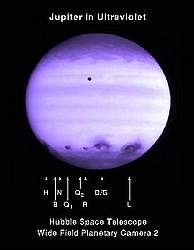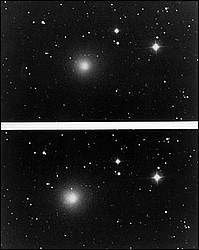
|
Title: Ultraviolet View of Comet Impacts
Caption: This Hubble Space Telescope image shows Jupiter's at a wavelength of 2550 Angstroms after several impacts by fragments of comet Shoemaker-Levy 9. A large, dark patch from the impact of fragment H is visible rising on the morning (left) side. Proceeding to the right, other dark spots were caused by impacts of fragments Q1, R, D and G (now one large spot), and L, with L covering the largest area. Small dark spots from B, N, and Q2 are also discernible. The spots are very dark at ultraviolet wavelengths because a large quantity of dust was deposited high in Jupiter's stratosphere, absorbing the sunlight. By watching the evolution of these features it was possible to determine wind speeds in the stratosphere. Jupiter's moon, Io, is the dark spot just above the center of the planet.
Copyright:(c) Public Domain
Credit: Hubble Space Telescope Comet Team and NASA
|


